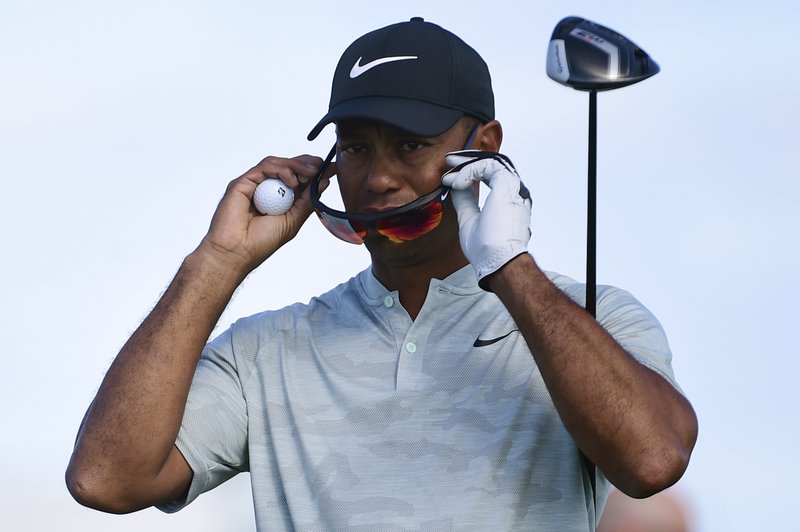
Tiger Woods adjusts his sunglasses before hitting from the seventh hole during the first round of the Hero World Challenge at the Albany Golf Club in Nassau, Bahamas, Thursday, Nov. 29, 2018. Woods now is No. 13 in the world as he hosts this holiday tournament for the 20th time. (AP Photo/Dante Carrer)
NASSAU, Bahamas — Upon further review, Tiger Woods hit the ball more than once trying to escape from a palm bush.
And under an 18-month-old decision in the Rules of Golf, he avoided a penalty Friday in the Hero World Challenge because PGA Tour officials — and Woods — could only see the violation through a high-definition replay in slow motion.
The decision from May 2017 says that a player is not deemed to have broken a rule if it could not reasonably be seen with the naked eye.
“I didn’t feel like I made contact twice,” Woods said. “In slow motion, you can see I did hit it twice. But in real time, I didn’t feel that at all.”
Woods hit his tee shot right of the 18th fairway at Albany Golf Club barely into a palm bush. He took a stance with his right knee on the ground and his left leg extended to get an 8-iron around the ball, barely took the club back and punched — in real-time it looked more like a scoop — back to the light rough.
Questions immediately arose, starting with whether Woods pushed, scraped or spooned the shot (Rule 14-1a).
PGA Tour officials looked at the video and after a lengthy review determined that the ball struck the club twice.
“We did determine that he made a stroke at it,” said Mark Russell, vice president of rules and competition, differentiating between spooning it. “And when he did that, Tiger said that he did not think he hit the ball twice. Looking at in the regular speed on a high definition television, you couldn’t tell that at all. But when you slowed it down to ultra-slow motion, high definition television, you could see where the club did stay on the clubface quite a bit of time, and it looked like he might have hit it twice.
“But there’s no way he could tell that.”
Woods walked out of the scoring area 25 minutes later with a smile, much different from how he walked in. Woods made double bogey on the last hole, dropping him to a 3-under 69 that left him eight shots out of the lead going into the weekend.
Golf has been out front in the use of advanced video for the last five years, and it responded again a year ago in May to respond to increasing debates over television reviews in golf.
Decision 34-3/9 reads in part, “Video technology, especially the use of methods such as high resolution or close-up camera shots that can be replayed in slow motion, has the potential to undermine this essential characteristic of the game by identifying the existence of facts that could not reasonably be identified in any other way.”
One incident that prompted the new decision involved Anna Nordqvist in a playoff at the 2016 U.S. Women’s Open when her club nicked the sand while she was playing from a fairway bunker. She was penalized for the violation, even though she could not have seen it with the naked eye.
In Friday’s case, Russell said Woods would have received a one-shot penalty if it was clear from real-time TV that he hit the ball more than once.